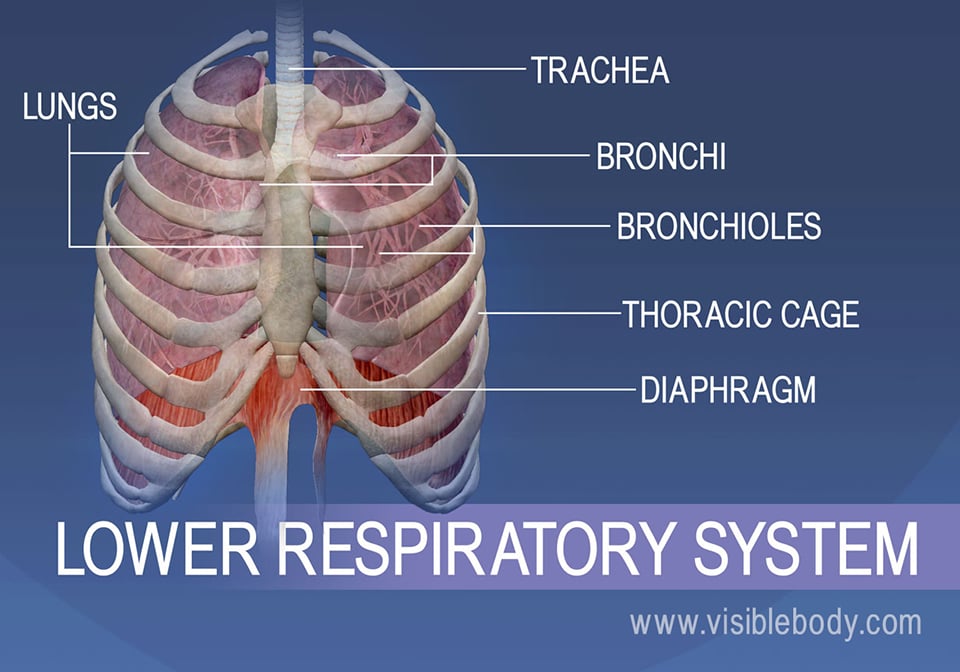Respiratory System
The respiratory system consists of the lungs, airways (trachea, bronchi, bronchioles), diaphragm, larynx, pharynx, nose, and mouth. Its primary function is gas exchange: inhaling oxygen and exhaling carbon dioxide. It also offers defense against harmful particles and microorganisms, as well as enabling olfaction and vocalization.
Overview
The respiratory system is a complex network that facilitates the essential process of breathing. Its main components, including the lungs, trachea, bronchi, diaphragm, and alveoli, work in unison to maintain oxygen supply and carbon dioxide removal. Additionally, it filters the air, regulates humidity, and aids in speech production.
Function
The key function of the respiratory system is the intake of oxygen, which is crucial for cellular metabolism, and the elimination of carbon dioxide, a metabolic byproduct. The exchange of gases occurs within the alveoli, where oxygen diffuses into nearby capillaries and carbon dioxide is removed.
Additionally, the respiratory system:
- Thermoregulation: It adjusts the temperature of inhaled air.
- Humidification: Moisturizes air to appropriate body humidity levels.
- Protection: Filters out harmful particles and microorganisms.
- Phonation: Facilitates sound production through vocal cord vibration.
- Olfaction: Airflow carries molecules to olfactory receptors for smell perception.
- Acid-Base Regulation: Maintains blood pH by controlling carbon dioxide levels.
Anatomy
The respiratory system can be anatomically divided into the upper and lower respiratory tracts:
- Upper Respiratory Tract: Includes the nose, nasal cavity, sinuses, pharynx, and larynx. It filters, warms, and humidifies incoming air.
- Lower Respiratory Tract: Consists of the trachea, bronchi, bronchioles, and lungs. Here, the bronchi and bronchioles form a branching “tracheobronchial tree,” which delivers air to the alveoli for gas exchange.


How the Respiratory System Functions
The respiratory system is intricately linked with the circulatory system. Oxygen enters the alveoli, diffuses into capillaries, and binds to hemoglobin in red blood cells, where it is transported to body tissues. Simultaneously, carbon dioxide, a waste product of cellular respiration, is carried from the tissues back to the lungs, where it is expelled during exhalation.
Additional Protective Mechanisms
The respiratory system provides protective barriers:
- Cilia and Mucus: Trap and remove dust, allergens, and pathogens from the airways.
- Reflexes: Coughing and sneezing expel irritants and protect the respiratory passages.
Conditions and Disorders
Various conditions can impair the function of the respiratory system, including:
- Asthma and Chronic Obstructive Pulmonary Disease (COPD), which constrict airways.
- Respiratory infections such as pneumonia, bronchitis, and sinusitis.
- Allergic conditions like rhinitis, which inflame the airways.
- Lung diseases like pulmonary fibrosis or lung cancer.
Diagnostic Tests
Healthcare providers assess respiratory health through:
- Pulse oximetry, to monitor oxygen levels.
- Pulmonary function tests, to measure lung capacity and airflow.
- Chest X-rays and blood gas analysis, to detect abnormalities in lung structure and gas exchange efficiency.
Care and Prevention
To maintain respiratory health:
- Avoid smoking and exposure to pollutants.
- Stay hydrated to keep lung secretions thin.
- Exercise regularly to strengthen respiratory muscles.
- Prevent infections through vaccinations and good hygiene.
- maintain better diet.
Conclusion
The respiratory system is essential for maintaining oxygen supply and removing carbon dioxide, thereby sustaining cellular energy production and homeostasis.

